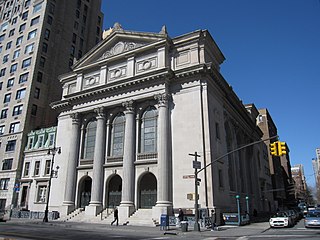Related Research Articles

Rabbinic literature, in its broadest sense, is the entire spectrum of rabbinic writings throughout Jewish history. However, the term often refers specifically to literature from the Talmudic era, as opposed to medieval and modern rabbinic writing, and thus corresponds with the Hebrew term Sifrut Chazal. This more specific sense of "Rabbinic literature"—referring to the Talmudim, Midrash, and related writings, but hardly ever to later texts—is how the term is generally intended when used in contemporary academic writing. The terms mefareshim and parshanim (commentaries/commentators) almost always refer to later, post-Talmudic writers of rabbinic glosses on Biblical and Talmudic texts.

Jewish philosophy includes all philosophy carried out by Jews, or in relation to the religion of Judaism. Until modern Haskalah and Jewish emancipation, Jewish philosophy was preoccupied with attempts to reconcile coherent new ideas into the tradition of Rabbinic Judaism, thus organizing emergent ideas that are not necessarily Jewish into a uniquely Jewish scholastic framework and world-view. With their acceptance into modern society, Jews with secular educations embraced or developed entirely new philosophies to meet the demands of the world in which they now found themselves.

Moshe Chaim Luzzatto, also known by the Hebrew acronym RaMCHaL, was a prominent Italian Jewish rabbi, kabbalist, and philosopher.
In Jewish law and history, Acharonim are the leading rabbis and poskim living from roughly the 16th century to the present, and more specifically since the writing of the Shulchan Aruch in 1563 CE.

Hebrew literature consists of ancient, medieval, and modern writings in the Hebrew language. It is one of the primary forms of Jewish literature, though there have been cases of literature written in Hebrew by non-Jews. Hebrew literature was produced in many different parts of the world throughout the medieval and modern eras, while contemporary Hebrew literature is largely Israeli literature. In 1966, Agnon won the Nobel Prize for Literature for novels and short stories that employ a unique blend of biblical, Talmudic and modern Hebrew, making him the first Hebrew writer to receive this award.

Kaufmann Kohler was a German-born Jewish American biblical scholar and critic, theologian, Reform rabbi, and contributing editor to numerous articles of The Jewish Encyclopedia (1906).

Jewish literature includes works written by Jews on Jewish themes, literary works written in Jewish languages on various themes, and literary works in any language written by Jewish writers. Ancient Jewish literature includes Biblical literature and rabbinic literature. Medieval Jewish literature includes not only rabbinic literature but also ethical literature, philosophical literature, mystical literature, various other forms of prose including history and fiction, and various forms of poetry of both religious and secular varieties. The production of Jewish literature has flowered with the modern emergence of secular Jewish culture. Modern Jewish literature has included Yiddish literature, Judeo-Tat literature, Ladino literature, Hebrew literature, and Jewish American literature.

The Congregation Shearith Israel – often called The Spanish and Portuguese Synagogue – is the oldest Jewish congregation in the United States. It was established in 1654 in New Amsterdam by Jews who arrived from Dutch Brazil. Until 1825, when Jewish immigrants from Germany established a congregation, it was the only Jewish congregation in New York City.
Mekitze Nirdamim is a literary society dedicated to the retrieval, preservation, and publication of medieval Hebrew texts. It was first established at Lyck, Prussia in 1861, and is now based out of Jerusalem, Israel.

Abraham de Sola was a Canadian rabbi, author, Orientalist, and academic. Originating from a large renowned family of rabbis and scholars, De Sola was recognized as one of the foremost leaders of Orthodox Judaism in North America during the latter half of the nineteenth century.
Congregation Beth Israel Judea is a Reform synagogue located at 625 Brotherhood Way in San Francisco, California. It is the result of the merger of the Conservative Congregation Beth Israel and the Reform Temple Judea.
The following outline is provided as an overview of and topical guide to Judaism:
Palestinian rabbis encompasses all rabbis who lived in the region known as Palestine up until modern times, but most significantly refers to the early Jewish sages who dwelled in the ancient Holy Land and compiled the Mishna and its later commentary, the Jerusalem Talmud. These rabbis lived between 150 BCE and 400 CE and during the Talmudic and later Geonic period, they exerted influence over Syria and Egypt, while the authorities in Babylonia had held sway over the Jews of Iraq and Iran. While the Jerusalem Talmud was not to become authoritative against the Babylonian, the liturgy developed by Palestinian rabbis was later destined to form the foundation of the minhag of nearly all the Ashkenazic communities across Europe.

Samuel Myer Isaacs was a Dutch-born American educator, philanthropist and rabbi. He was the second Jewish spiritual leader in the United States to teach in English instead of Hebrew or German.

Myer Samuel Isaacs was a Jewish-American lawyer and judge from New York.
Adolph Lewis Sanger was a Jewish-American lawyer from New York.
Benjamin Franklin Peixotto was a Jewish-American lawyer and diplomat.
Joshua Bloch was a Lithuanian-born Jewish-American rabbi and librarian.
Samuel Harry Goldenson was a Polish-born Jewish-American rabbi.
References
- ↑ American Jewish Yearbook
- ↑ American Jewish Yearbook
- ↑ Landman, Isaac, ed. (1941). The Universal Jewish Encyclopedia. Vol. 5. New York, N.Y.: The Universal Jewish Encyclopedia, Inc. pp. 594–595 – via Google Books.